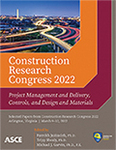Investigation of Relationship between Geotechnical Parameters and Electrical Resistivity of Sandy Soils
Publication: Construction Research Congress 2022
ABSTRACT
Subsurface investigation is one of the most critical phases of any construction project. An insufficient subsurface investigation is the primary source of change orders in 20 to 50% of infrastructure projects and may lead to costly failures due to uncertainties during the construction phase. Due to inherent limitations of conventional subsurface investigation methods, characterization of soil physical parameters using quick and non-invasive soil investigation methods (e.g., electrical resistivity) has been of interest to researchers. Developing proper relationships between electrical resistivity and geotechnical parameters helps to characterize the soil parameters at any location/depth. This paper aims to investigate the effects of water content, dry unit weight, fine fraction, and clay fraction on the electrical resistivity of sandy soils and create appropriate models for estimating them based on the electrical resistivity values. The linear regression analyses were performed using 100 observations obtained from laboratory testing (physical property and electrical resistivity tests). The results show a significant relationship between water content, dry unit weight, and clay fraction with electrical resistivity. The results also show that an increase in water content, dry unit weight, and clay fraction results in a decrease in the electrical resistivity. These findings contribute to the body of knowledge by identifying the influencing geotechnical parameters and quantifying the relationships between electrical resistivity and geotechnical parameters of sandy soils. It is expected that this research helps construction engineers and managers to have a rapid and continuous assessment of subsurface characteristics in the field to avoid costly failures.
Get full access to this article
View all available purchase options and get full access to this chapter.
REFERENCES
Adhikari, I., Baral, A., Zahed, E., Abediniangerabi, B., and Shahandashti, M. (2021). Early stage multi-criteria decision support system for recommending slope repair methods. Civil Engineering and Environmental Systems, 1–18.
Babić, B., Prager, A., and Rukavina, T. (2000). Effect of fine particles on some characteristics of granular base courses. Materials and structures, 33(7), 419–424.
Baral, A., Pourmand, P., Adhikari, I., Abediniangerabi, B., and Shahandashti, M. (2021). A GIS-Based Data Integration Approach for Rainfall-Induced Slope Failure Susceptibility Mapping in Clayey Soils. ASCE Natural Hazard Review, 22(3): 04021026.
Baynes, F. J. (2010). Sources of geotechnical risk. Quarterly Journal of Engineering Geology and Hydrogeology, 43, 321–331.
Bery, A. A., and Ismail, N. E. H. (2018). Empirical correlation between electrical resistivity and engineering properties of soils. Soil Mechanics and Foundation Engineering, 54(6), 425–429.
Bery, A. A., and Saad, R. (2012). Tropical clayey sand soil’s behaviour analysis and its empirical correlations via geophysics electrical resistivity method and engineering soil characterizations. International Journal of Geosciences, 3(1), 111–116.
Bhatt, S., and Jain, P. K. (2014). Correlation between electrical resistivity and water content of sand–a statistical approach. Am. Int. J. Res. Sci. Technol. Eng. Math, 6(2), 115–121.
Boeckmann, A. Z., and Loehr, J. E. (2016). Influence of geotechnical investigation and subsurface conditions on claims, change orders, and overruns.
Cabalar, A. F. (2011). The effects of fines on the behaviour of a sand mixture. Geotechnical and Geological Engineering, 29(1), 91–100.
Cosenza, P., Marmet, E., Rejiba, F., Cui, Y. J., Tabbagh, A., and Charlery, Y. (2006). Correlations between geotechnical and electrical data: A case study at Garchy in France. Journal of Applied Geophysics, 60(3-4), 165–178.
Huang, H., Tutumluer, E., and Dombrow, W. (2009). Laboratory characterization of fouled railroad ballast behavior. Transportation research record, 2117(1), 93–101.
Indraratna, B., Salim, W., and Rujikiatkamjorn, C. (2011). Advanced rail geotechnology-ballasted track. CRC press.
Mohammed, M. A., Senosy, M. M., and Abudeif, A. M. (2019). Derivation of empirical relationships between geotechnical parameters and resistivity using electrical resistivity tomography (ERT) and borehole data at Sohag University site, upper Egypt. Journal of African Earth Sciences, 158, 103563.
Naeini, S. A., and Baziar, M. H. (2004). Effect of fines content on steady-state strength of mixed and layered samples of a sand. Soil Dynamics and Earthquake Engineering, 24(3), 181–187.
Seif El Dine, B., Dupla, J. C., Frank, R., Canou, J., and Kazan, Y. (2010). Mechanical characterization of matrix coarse-grained soils with a large-sized triaxial device. Canadian Geotechnical Journal, 47(4), 425–438.
Shahandashti, M., Hossain, S., Baral, A., Adhikari, I., Pourmand, P., and Abediniangerabi, B. (2020). Slope Repair and Maintenance Management System. Texas Department of Transportation. https://rip.trb.org/view/1804045.
Sirles, P. C. (2006). Use of geophysics for transportation projects (Vol. 357). Transportation Research Board.
Trinh, V. N., Tang, A. M., Cui, Y. J., Dupla, J. C., Canou, J., Calon, N., Lambert, L., Robinet, A., and Schoen, O. (2012). Mechanical characterisation of the fouled ballast in ancient railway track substructure by large-scale triaxial tests. Soils and foundations, 52(3), 511–523.
Verdugo, R., and de la Hoz, K. (2007). Strength and stiffness of coarse granular soils. In Soil stress-strain behavior: Measurement, modeling and analysis (pp. 243–252). Springer, Dordrecht.
Zhou, M., Wang, J., Cai, L., Fan, Y., and Zheng, Z. (2015). Laboratory investigations on factors affecting soil electrical resistivity and the measurement. IEEE Transactions on Industry Applications, 51(6), 5358–5365.
Zhu, J. J., Kang, H. Z., and Gonda, Y. (2007). Application of Wenner configuration to estimate soil water content in pine plantations on sandy land. Pedosphere, 17(6), 801–812.
Information & Authors
Information
Published In
History
Published online: Mar 7, 2022
Authors
Metrics & Citations
Metrics
Citations
Download citation
If you have the appropriate software installed, you can download article citation data to the citation manager of your choice. Simply select your manager software from the list below and click Download.
Cited by
- Mina Zamanian, Pooya Darghiasi, Mohsen Shahandashti, Empirical Study of the Correlation between Geoelectrical and Soil-Index Properties of Clayey Soils, Construction Research Congress 2024, 10.1061/9780784485279.073, (731-740), (2024).
- Pooya Darghiasi, Mina Zamanian, Mohsen Shahandashti, Enhancing Winter Maintenance Decision Making through Deep Learning-Based Road Surface Temperature Estimation, Construction Research Congress 2024, 10.1061/9780784485279.070, (701-711), (2024).
